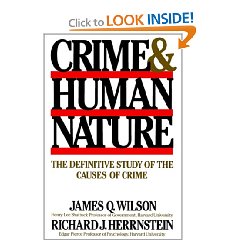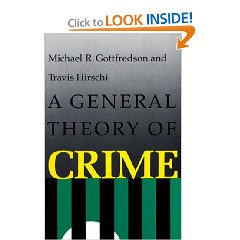 Crime and Human Nature (read an in depth review of the book here)
Crime and Human Nature (read an in depth review of the book here)Chapter 10
Crime and Criminology
So far we have been discussing criminological theory of a specialized nature. The individuals and the theories we have addressed here have been classified as choice, conflict, labeling, control, positivist, or some other kind of theory. We have pointed out there are criticisms to most of these theories. One criticism is that they do not explain enough or all crime.
As a result, modern criminal theory has begun to integrate multiple ideas in order to answer more questions. Criminologists have created multi-factor theories that attempt to blend independent concepts into broader explanations of crime and criminality. This makes good sense, since there is no one theory that thus far has been able to account for and explain all crime the idea is that we would take the strengths of several theories and blend them together to accomplish more explanatory power.
There are two primary reasons for the growth of integrated theory. The first one is practicality. We now have large, extensive datasets that allow for the integration of theoretical crime oriented concepts. The second reason is substantive, and most important, single-factor theories only focus on who is a criminal and who is not. There is not much more depth to the analysis than that. The onset of criminality becomes the focal concern.
Integrated theories have helped shed new light on chronic or persistent offenders. Single-factor theories, as we have seen, have trouble explaining why only a select few people who are exposed to criminal influences actually end up committing crimes.
However, by integrating the ideas of social ecology, sociology, psychology, and biology, we can better address these issues.
Brief Overview of Integrated Theories
Integrated theories are generally divided into different groupings based on their approach to human development and change. here we have categorized them into two unique approaches:
1. Life-course
2. Latent Trait Theories
Life-Course Theory. This theory takes the approach that the propensity to commit crime is not so much stable throughout the life course but rather criminality is a developmental process. Life course theorists realize that as people mature, the factors that influence their behavior also changes. Criminality is a dynamic process with many influences impacting individuals throughout the life course. As people age and evolve throughout the life course they are constantly changing their perceptions and experiences which serve to shape and change the direction of their behavior, sometimes for the worse and sometimes for the better.
Latent Trait Theory was proposed by Rowe, Osgood, and Nicewander to explain crime over the life cycle. The idea being that a lot of people have a personal attribute or characteristic that controls the inclination to criminal behavior. Because latent traits are stable, just as biology is stable, offending over time is based on opportunities to commit crime and not on propensity, the propensity is stable. As people age through the life course this latent trait is always there and always a stable presence in the background, directing behavior and subsequently shaping the course of their lives. Some view latent trait theories as incorporating trait theory (personality and temper) and rational choice theory (opportunity and suitability of targets).
Life Course Theories
These theories are multidimensional; suggesting that criminality has multiple roots including maladjusted personality, educational failure, and dysfunctional family relations. Criminality, according to this view, is not attributed to one single cause but rather to many that occur over the life course. The main premise of life course theory concludes that multiple social, personal, and economic factors can influence criminality and that all of these change over time as does criminal involvement and opportunity. One of the most significant studies that have ever been done is called "The Gluecks" study named after Sheldon and Eleanor Glueck. The study was longitudinal and followed the careers of known delinquent and non-delinquent individuals to see what set the groups apart. This study was an early precursor of life course theory. The Gluecks identified several factors that were related to persistent offending. The most important one was family relations and as part of family relations, they found that the quality of discipline and the emotional ties with parents were extremely important. The Gluecks also went beyond social factors and looked at biological traits and psychology. They looked at things like IQ, body type, and personality. They found that the physical and mental factors were of relevance. Children with low IQ, a mental disease, and a powerful (Mezomorph) physiology physique were the ones most likely to become persistent offenders. The Gluecks study went largely undiscovered or unexploited when criminology went towards a more social-psychological approach. Their research was rediscovered about ten years ago by Sampson and Laub and reanalyzed.
The life course is viewed as a series of progressive milestones including finishing school, entering the job market and the workforce, getting married and settling down, and having children. The various life stages can occur too early, too late, or on time. crime is therefore viewed as an outgrowth of these progressions and is therefore developmental.
The following information reviews some of the life course developmental concepts.
1. Problem Behavior Syndrome - rather than being portrayed as the outcome of social problems experienced by youth, crime is viewed by developmental theorists as just another social problem faced by youth, similar to substance abuse, gambling, promiscuity, smoking, sexual abuse, gang involvement, poverty, and the like. People who suffer from one of these are more likely to suffer from a variety of others as well. The idea is that most forms of antisocial behavior have similar developmental patters and trajectories. Individuals experiencing problem behavior syndrome are also more likely to experience a variety of personality problems also including impulsiveness, rebelliousness, and conflict.
2. Age and Crime Onset - Most life course theorists assume that the likelihood of engaging in a criminal careers is established early and early deviance is the best predictor of later deviance. In other words, early aggression begets later aggression.
So, why do some people/kids start committing crime at an early age? If we can identify the answer to this question we might stand our greatest hope of preventing crime. The conventional wisdom and a lot of research suggests that poor parental discipline and supervision are keys to early onset criminality. Thinking back on the social process theory discussion, kids who are improperly socialized by unskilled unqualified parents are the ones most likely to rebel and resist and establish relationships with delinquent peers.
Male and female differences in life course criminality - Males who engage in early criminality tend to follow a life course trajectory that has them encountering problems later in life at work and through the use of drugs and alcohol. For females, early criminality tends to lead to later problems in personal relationships, depression, suicide and health risks. Further, males tend to show stronger links to aggression through the life course than females.
Theories:
Sampson and Laub: Age-Graded Theory
The theory is predicated on the idea referred to as age-graded informal controls. The primary function is bonding that occurs in the family, school, among peers, and later in life through marriage and employment. The bonds people establish through these age-graded activities is said to inhibit criminal behavior. The book provides a thorough explanation of the theory.
Terrie Moffitt contributed to developmental theory through her identification of what she refers to as adolescent limited offenders -- those adolescents whose antisocial behavior peaks during adolescence and then declines to the point of desistance. These individuals may be referred to as typical teenagers with characteristic rebellious behavior that they age out of. The life course persisters on the other hand are those individuals who engage in crime and delinquency at a young age and their behavior sets the stage for a career of offending. These individuals are more likely to manifest additional abnormal traits like low verbal skills, impaired reasoning, and poor memory function. Research suggests that these patterns are persistent and accurate.
Latent Trait Approach
This is a biological approach assuming that some trait or characteristic, often present at birth, though occasionally acquired early in life, can account for the onset of criminality. Therefore, the propensity for crime remains stable throughout life with only social forces and opportunity influencing the likelihood of criminality. We have talked about a variety of traits in the presence of criminality like ADHD, impulsivity, etc. Suspected latent traits include low IQ, impulsive personality, genetic abnormalities, and even environmental influences. The general idea here is that those who have the trait are at risk of becoming criminals and those who lack the trait have a considerably reduced risk.
Theories:
 Crime and Human Nature (read an in depth review of the book here)
Crime and Human Nature (read an in depth review of the book here)
One of the most widely renowned books in criminality was written by two researchers named Wilson and Hernstein. The book is called Crime and Human Nature. The argument made throughout the book is that personal traits like genetics, IQ, and body build may actually outweigh the importance of social variables as predictors of criminality. Their integrated theory includes elements of biology, sociology, personality, rational choice, structure, and social process theories. According to Wilson and Hernstein, all human behavior is determined by its perceived consequences. The weighing of potential gains and losses are done for certain behaviors to determine which will be acted on. This is a function of rational choice. The larger the perception of rewards, the greater the tendency to commit the crime. The theory is integrative because it assumes that biological and psychological traits influence the choice making process. They find a link between a person's decision to commit crime and such biosocial factors as low IQ, body type, and genetics (parent criminality). Psychological traits including impulsivity or extroversion are also related. These "traits" do not mean a person with them will be a criminal but all things being equal, those who have them are more likely to choose crime over non-crime. Wilson and Hernstein did not ignore the social factors that are known to impact criminality. They feel that biosocial, psychological, and social conditions can all work together to influence behavior patterns. They have assembled a vast amount of support for their notions and theory but critics of their work point out that much of their supporting evidence is plagued by sampling inadequacy, questionable measurement techniques, and observer bias (Meyer and Krienert, 2009, quoted).
 General Theory of Crime
General Theory of Crime
This is possibly the second most important integrated theory of crime. Two criminologists, Gottfredson and Hirschi integrate control theory with biosocial, psychological, routine activities, and rational choice theories. Gottfredson and Hirschi see the criminal offender and the criminal act as two separate concepts. The criminal act, like robberies and burglaries, are negative acts people do when they think it will be advantageous to them. This is like rational choice theory and routine activities in that people weigh rewards and punishments and the accessibility of targets. On the other hand, criminal offenders are individuals who are predisposed to commit crime. This predisposition remains constant over time but the opportunity changes. The key element in Gottfredson and Hirschi's general theory of crime is that individuals vary in their tendency to commit crimes. This is based on an individual's self control. People without good self control tend to be impulsive. Impulsive people are insensitive, physical, risk taking, short sighted, and nonverbal. They have an orientation towards immediate gratification and are less likely to feel share, therefore more likely to engage in criminal acts that they find pleasurable. Similarly, this desire for easy pleasure can be seen in other noncriminal behaviors as well like smoking, drinking, gambling, and illicit sex. Poor self control can be traced to inadequate child-rearing practices. Parents who don't recognize deviant behavior don't punish it and therefore they produce kids who have low self control. The lack of self control is a natural phenomenon that will occur unless steps are taken to avoid it. It occurs early in life and will remain stable into and through adulthood. Unlike most other theories that explain narrow aspects of criminal behavior, Gottfredson and Hirschi argue that their theory of self control applies to all crimes from murder to corporate theft (Meyer and Krienert, 2009, quoted).
Control Balance Theory
This theory proposed by Charles Tittle suggests that control has two main dimensions or components: those amount of control one is subject to by others and the amount of control one can exercise over others. When balance between the two is attained we have rule conformity but when there is an imbalance according to Tittle people choose one of three adaptations to restore or reestablish the balance: 1) predation - involves physical violence against others; 2) defiance - challenges control but does not invoke violence; 3) submission - involves passive obedience to the demands of others.
Most of these theories tend to suggest that people can't or don't really change their lives, for many, once headed down the wrong path the suggestion here is that they continue down the path. Is this true? Think about examples you might be familiar with, people you know, also read a bit about Cody Scott again and look into the background and story of Stanley "Tookie" Williams, also read this - it's an interesting history of The Crips.
Watch this video and post to the questionss.
True Life: I'm in the System - Watch the video posted in the weekly module and and respond to the questions
The reality-based show will follow one inmate for several days at the Suffolk County House of Correction at South Bay, recording the daily routine of the offender. The Boston segment is one of a three-piece criminal justice episode. The other two segments will follow a young parolee in New York and a woman whose boyfriend is incarcerated in Oakland, CA
